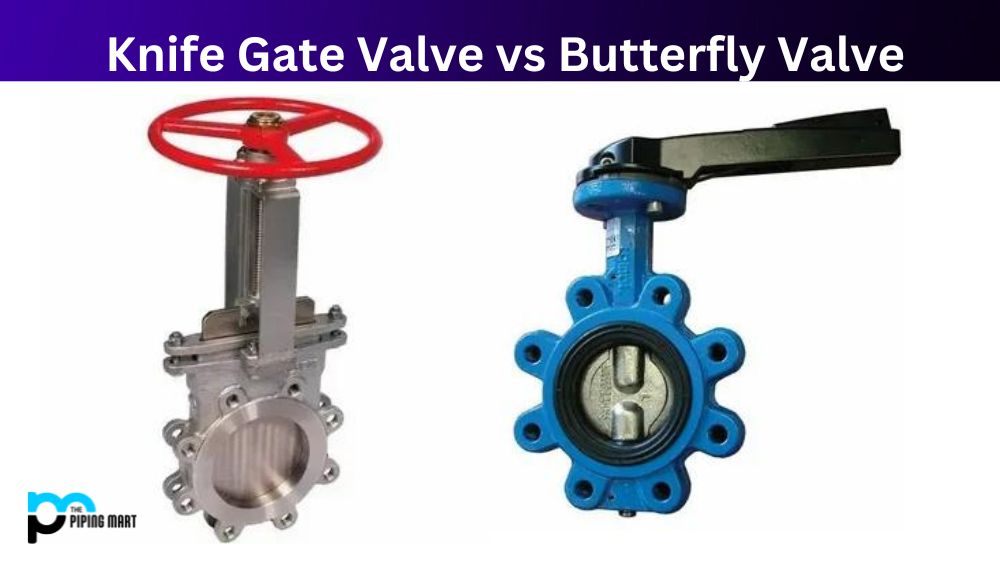When choosing valves for a process system, it’s important to consider the system’s specific requirements and working conditions. Two popular types of valves used in various fluid control applications are knife gate valves and butterfly valves. These valves have unique features, advantages, and disadvantages, making it essential to know the differences between them. In this blog post, we’ll discuss the key differences between knife gate valves and butterfly valves to help you make an informed decision for your system.
Knife Gate Valve
Knife Gate Valve is a one-way valve primarily used in industrial processes. It is designed with a gate which rises in order to open the valve and falls back into the seat to close it. The gate can cut through heavy viscous materials, thus allowing for precise control over operations where large amounts of pressure are present. The typically rectangular shape ensures minimal disturbance and turbulence at high flow rates, making Knife Gate Valves an ideal choice for granular or pulverized solids applications.
Butterfly Valve
A butterfly valve is a type of flow control device used to regulate the flow of liquids or gases. It consists of a disk-shaped closure element mounted on a rotating shaft and fitted with an actuator, such as a lever, gearbox, electric motor or pneumatic cylinder. When the actuator is operated, it rotates the disk closing or opening the valve to allow flow through. Butterfly valves are capable of regulating very high flows in comparison to other conventional valves.
Difference Between Knife Gate Valve and Butterfly Valve
Design
Knife gate valves are designed as unidirectional and bidirectional gate valves that operate on the principle of a gate sliding across the flow stream to open or close. The gate makes a tight seal between the valve body and the sealing surface. On the other hand, butterfly valves are designed as rotary valves that use a disc to regulate fluid flow. The disc is rotated at an angle to open or close the valve. Butterfly valves can be designed with a lug type, wafer type, or double-flanged type.
Applications
Knife gate valves are commonly used in applications requiring tight shutoff and robust construction. They are ideal for duties involving viscous fluids, abrasive slurries, fibrous materials, and dirty fluids that can cause other valve types to fail prematurely. Butterfly valves are typically used in applications where flow control is required, and shutoff efficiency is not a vital factor. They are well-suited for clean fluids, gases, and low-pressure systems.
Actuation
Knife gate valves are typically actuated by electric, pneumatic, or hydraulic actuators, which provide accurate control and precise gate movement. These actuators can be selected as per the torque requirement of the valve. Manual or automatic actuators can actuate butterfly valves, including electric, pneumatic, hydraulic, or gear operators.
Maintenance
Knife gate valves are relatively easy to maintain due to their simple design, making them easy to disassemble and inspect. They are designed with fewer moving parts that can wear out faster, making them less prone to failure. Butterfly valves are less expensive than knife gate valves, but they are prone to wear and tear and need frequent replacement of parts like seats and discs.
Cost
Knife gate valves are typically more expensive than butterfly valves due to their robust construction and durable design. They are also more expensive to operate and maintain due to their higher torque requirements and periodic parts replacement. Butterfly valves are less expensive to purchase, operate, and maintain, making them popular for low-pressure systems.
Conclusion:
Choosing between a knife gate valve and a butterfly valve depends on the specific requirements of your system. Knife gate valves are ideal for applications requiring tight shutoff and robust construction. On the other hand, butterfly valves are best suited for flow control applications in low-pressure systems. By understanding the differences between these two types of valves, you can select the right type of valve for your process system. Consult a valve supplier or an expert in fluid control to help you make an informed decision.

Meet Bhavesh, a seasoned blogger with a wealth of knowledge and experience. From metal products manufacturing to retail, Bhavesh has a diverse background in various industries and is dedicated to sharing his insights and expertise with readers.




